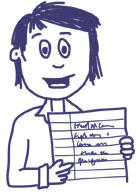
Electromagnetic Waves
Electromagnetic waves are invisible energy waves that travel through space and carry energy from one place to another. They include radio waves, microwaves, infrared radiation, visible light, ultraviolet radiation, X-rays, and gamma rays. These waves have different wavelengths and frequencies, enabling various applications like communication, cooking, and medical imaging.
What are radio waves?
Radio waves are a type of electromagnetic radiation, just like visible light, X-rays, and microwaves. They have the longest wavelengths and lowest frequencies among all types of electromagnetic waves. Radio waves are generated by accelerating electric charges, such as those in antennas or electrical circuits. They are made up of oscillating electric and magnetic fields. Types of radio waves are:
- Long-wave radio - wavelengths of 1-10km. Can be received at long distances, wavelengths bend around the curved surface of the earth.
- Short-wave radio - wavelengths of 10m-100m. Can be received at long distances. They reflect from the ionosphere.
- Bluetooth - uses short-wave radio waves.
- Medium-wave- reflect from the ionosphere.
Radio waves have wavelengths ranging from a few millimetres to thousands of kilometres. They travel at the speed of light (approximately 300,000 kilometres per second) through space and through the Earth's atmosphere. Radio waves can be easily transmitted through air, walls, and other obstacles, making them useful for long-distance communication.
Radio waves are primarily used for communication purposes, such as radio broadcasting, television broadcasting, cellular communication, WI-FI and Bluetooth. Radio waves are also used in radar systems for navigation, weather forecasting, air traffic control, and military applications. Additionally, radio waves are utilized in scientific research, such as radio astronomy for studying celestial objects in space.
What are microwaves?
Microwaves are a type of electromagnetic radiation, similar to radio waves and visible light, but with shorter wavelengths and higher frequencies. They fall between radio waves and infrared radiation on the electromagnetic spectrum. Microwaves are produced by various sources, including electronic devices and specialized equipment like microwave ovens.
Microwaves have wavelengths ranging from about one millimetre to one meter. They travel at the speed of light (approximately 300,000 kilometres per second) through space and through the Earth's atmosphere. Microwaves can penetrate through materials like air, glass, and some plastics, but they are absorbed by water, fats, and sugars.
The most common use of microwaves is in microwave ovens for cooking food quickly and efficiently. In a microwave oven, microwaves penetrate the food and cause water molecules to vibrate, generating heat and cooking the food from the inside out. Microwaves are also used in communication technologies, such as satellite communication, radar systems, and cellular networks. For example, microwave links are often used to transmit data between cell phone towers. In astronomy, microwaves are used to study celestial objects and phenomena, including the cosmic microwave background radiation, which is the residual radiation from the Big Bang. Additionally, microwaves have applications in medical imaging (like MRI and microwave thermography), industrial processes (like drying and heating), and scientific research.
What is Infrared Radiation?
Infrared radiation is a type of electromagnetic radiation, similar to visible light, but with longer wavelengths and lower frequencies. It falls between the visible and microwave portions of the electromagnetic spectrum. Infrared radiation is produced by objects that emit heat, such as the Sun, the human body, and hot objects like stoves and lamps.
Infrared radiation has wavelengths ranging from about 0.7 micrometers (┬Ám) to 1 millimeter (mm). It is invisible to the human eye, but we can feel it as heat when it interacts with our skin. Infrared radiation can penetrate certain materials, but it is absorbed and emitted by most objects, depending on their temperature and surface properties.
Infrared radiation has various practical applications in everyday life and technology. Some of these uses are infrared cameras to detect temperature, sensors on satellites and aircraft, infrared heaters, infrared singles used on remote controls, infrared saunas and lamps for relaxation and pain relief.
Key Words
Transverse waves - the oscillations travel up and down.
Electromagnetic (EM) waves - transverse waves that transfer energy from a source to an absorber. They travel at the same speed through air or a vacuum. EM waves form a continuous spectrum over a range of frequencies.
Refraction -waves cross a boundary between materials, the angle is changed.
Optical density - how quickly light can travel through it.
Optical fibres - thin glass or plastic fibres that can carry data over long distances.
Ultraviolet Radiation (UV) - found naturally in sunlight.
X-rays - pass easily through flesh but not so easily through denser materials like bones or metal.
Gramma Rays - used in medicine in patients to kill cancer cells.
Black body - an object that absorbs all of the radiation that hits it.
Also see Waves, Atoms & Radiation
PRACTICAL Infrared Radiation
Watch the video and have a go at writing out the steps of the practical.



